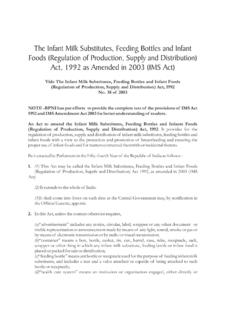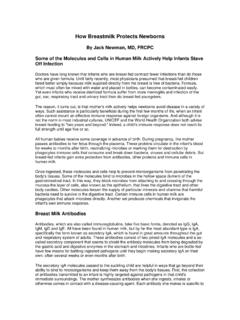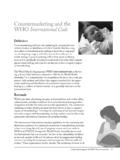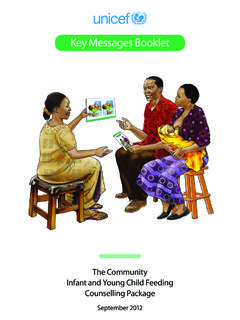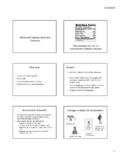Transcription of Global Strategy for Infant and Young Child Feeding
1 Global Strategyfor Infant andYoung ChildFeedingWorld Health OrganizationGenevaWHO Library Cataloguing-in-Publication DataGlobal Strategy for Infant and Young Child nutrition Feeding behavior health policy Health OrganizationII. UNICEFISBN 92 4 156221 8(NLM classification: WS 120) World Health Organization 2003 All rights reserved. Publications of the World Health Organization can be obtained fromMarketing and Dissemination, World Health Organization, 20 Avenue Appia, 1211 Geneva 27, Switzerland (tel: +41 22 791 2476; fax: +41 22 791 4857; Requests for permission to reproduce or translate WHO publi-cations whether for sale or for noncommercial distribution should be addressed toPublications, at the above address (fax: +41 22 791 4806.))
2 Email: by minimum graphicsPrinted in SingaporeContentsAbbreviationsivForeword vIntroduction1 Global Strategy for Infant and Young Child feeding5 Defining the challenge5 Determining the aim and objectives6 Promoting appropriate Feeding for infants and Young children7 Exercising other Feeding options10 Feeding in exceptionally difficult circumstances10 Improving Feeding practices12 Achieving the Strategy s objectives13 Implementing high-priority action15 For protection16 For promotion16 For support through the health care system16 For support in the community18 For support for Feeding infants and Young children inexceptionally
3 Difficult circumstances18 Obligations and responsibilities19 Governments19 Other concerned parties20 Health professional bodies20 Nongovernmental organizations includingcommunity-based support groups21 Commercial enterprises22 The social partners23 Other groups23 International organizations23 Conclusion25 AnnexResolution , Infant and Young Child nutrition 27 Endorsement of the UNICEF Executive Board30ivAbbreviationsFAOFood and Agriculture Organization of theUnited NationsHIV/AIDS Human immunodeficiency virus/acquiredimmunodeficiency syndromeILOI nternational Labour OrganizationUNAIDSJ oint United Nations Programme on HIV/AIDSUNFPAU nited Nations Population FundUNHCRU nited Nations High Commission for RefugeesUNICEFU nited Nations Children s FundWHOW orld Health OrganizationvForewordWHO and UNICEF jointly developed the Global Strategy forInfant and Young Child Feeding to revitalize world attention tothe impact that Feeding
4 Practices have on the nutritional status, growthand development, health, and thus the very survival of infants and Global Strategy is based on the evidence of nutrition s significancein the early months and years of life, and of the crucial role that appro-priate Feeding practices play in achieving optimal health outcomes. Lackof breastfeeding and especially lack of exclusive breastfeeding duringthe first half-year of life are important risk factors for Infant and Child -hood morbidity and mortality that are only compounded by inappro-priate complementary Feeding . The life-long impact includes poor schoolperformance, reduced productivity, and impaired intellectual andsocial Strategy is the result of a comprehensive two-year participatoryprocess.
5 The aim, from the outset, was to move towards formulating asound approach to alleviating the tragic burden borne by the world schildren 50 to 70% of the burden of diarrhoeal disease, measles,malaria and lower respiratory infections in childhood are attributableto undernutrition and to contribute to a lasting reduction in povertyand exercise provided an exceptional opportunity to re-examine criti-cally, in the light of the latest scientific and epidemiological evidence,the fundamental factors affecting Feeding practices for infants and youngchildren. At the same time, it renewed commitment to continuing jointaction consistent with the Baby-friendly Hospital Initiative, the Inter-national Code of Marketing of Breast-milk Substitutes, and the InnocentiDeclaration on the Protection, Promotion and Support of Strategy FOR Infant AND Young Child FEEDINGviThe Strategy is intended as a guide for action.
6 It identifies interventionswith a proven positive impact, it emphasizes providing mothers andfamilies the support they need to carry out their crucial roles, and itexplicitly defines the obligations and responsibilities in this regard ofgovernments, international organizations and other concerned are proud of the unanimous endorsement that the governing bodiesof our two agencies have pronounced in support of the The first necessary political step has been taken. It is nowtime for everyone concerned governments as well as all the otherinnumerable actors throughout society to move swiftly and deliber-ately to give tangible effect to the Strategy s vital aim and practicalobjectives.
7 There can be no delay in applying the accumulated knowl-edge and experience to help make our world a truly fit environmentwhere all children can thrive and achieve their full Harlem BrundtlandCarol BellamyMD, MPHE xecutive DirectorDirector-GeneralUnited Nations Children sWorld Health OrganizationFund1 The Global Strategy was endorsed, by consensus, on 18 May 2002 by the Fifty-fifthWorld Health Assembly, and on 16 September 2002 by the UNICEF Executive Board(see annex).11. IntroductionThe Executive Board of the World Health Organization, at its 101stsession in January 1998, called for a revitalization of the Global com-mitment to appropriate Infant and Young Child nutrition, and in par-ticular breastfeeding and complementary Feeding .
8 Subsequently, in closecollaboration with the United Nations Children s Fund, WHO organ-ized a consultation (Geneva, 13 17 March 2000) to assess Infant andyoung Child Feeding practices, review key interventions, and formulatea comprehensive Strategy for the next discussions at the Fifty-third World Health Assembly in May2000 and the 107th session of the Executive Board in January 2001 ofthe outline and critical issues of the Global Strategy , the Fifty-fourthWorld Health Assembly (May 2001) reviewed progress and requestedthe Director-General to submit the Strategy to the Executive Board atits 109th session and to the Fifty-fifth World Health Assembly, respec-tively in January and May their discussion of the draft of the Global Strategy , members ofthe Executive Board commended the setting in motion of the consulta-tive, science-based process that had led to its formulation as a guide fordeveloping country-specific approaches to improving Feeding also welcomed the Strategy s integrated and comprehensive ap-proach.
9 Several members made suggestions with regard to the exactwording of the draft Strategy . These suggestions were taken carefullyinto account in preparing the Strategy , as were comments from Mem-ber States following the Board s 109th session2 and observations of otherinterested parties, including professional associations, nongovernmentalorganizations and the processed-food industry. Stressing the validity ofa well-structured draft, the Executive Board recommended that theHealth Assembly endorse the Global Strategy and that Member States1 Resolution , paragraph 3(6).2 Provided in response to circular letter , dated 8 February Strategy FOR Infant AND Young Child FEEDING2implement it, as appropriate to national circumstances, in order to pro-mote optimal Feeding for all infants and Young emerging policy frameworkFrom the outset it was agreed that the Global Strategy should build onpast and continuing achievements particularly the Baby-friendlyHospital Initiative (1991), the International Code of Marketing ofBreast-milk Substitutes (1981) and the Innocenti Declaration on theProtection, Promotion and Support of Breastfeeding (1990)
10 In theoverall context of national policies and programmes on nutrition andchild health, and consistent with the World Declaration and Plan ofAction for However, it should go further and emphasize theneed for comprehensive national policies on Infant and Young childfeeding, including guidelines on ensuring appropriate Feeding of in-fants and Young children in exceptionally difficult circumstances, andthe need to ensure that all health services protect, promote and supportexclusive breastfeeding and timely and adequate complementary feed-ing with continued principles guided the development of the Strategy : it should begrounded on the best available scientific and epidemiological evidence,and it should be as participatory as possible.










